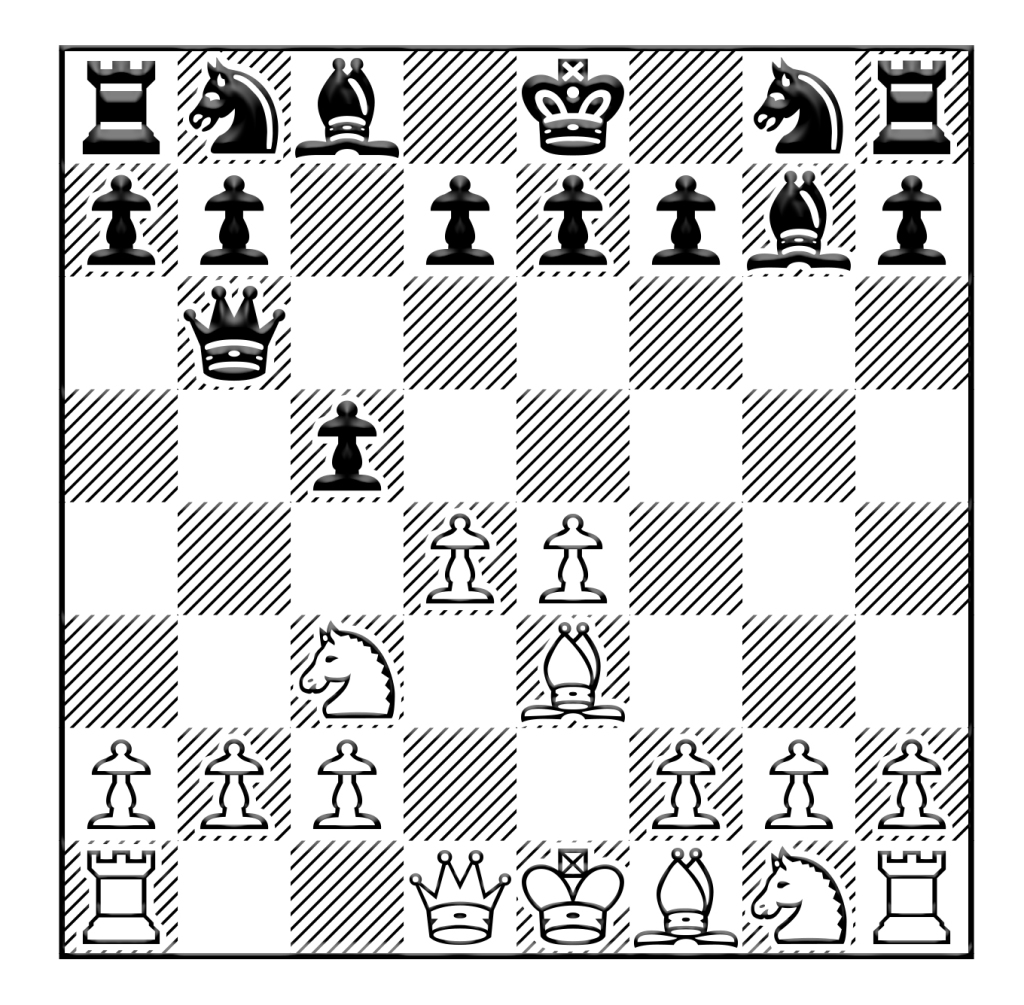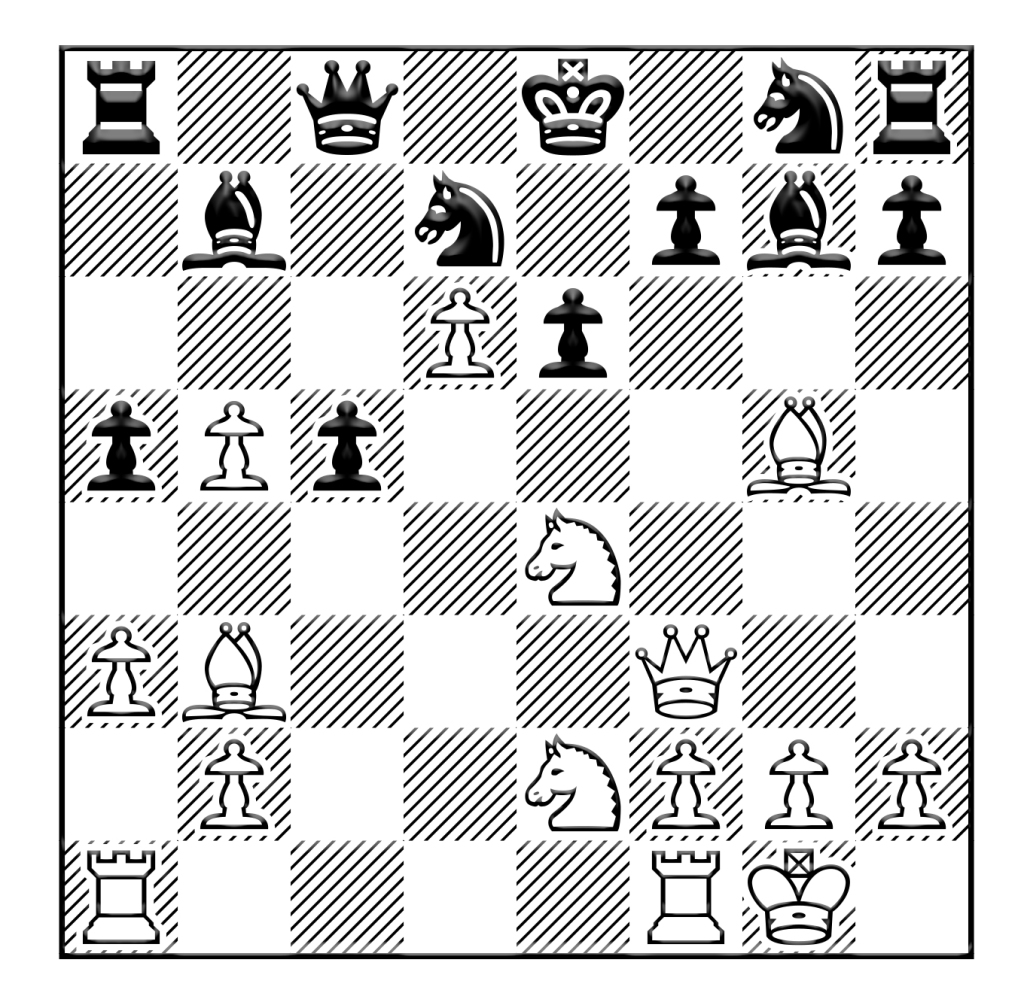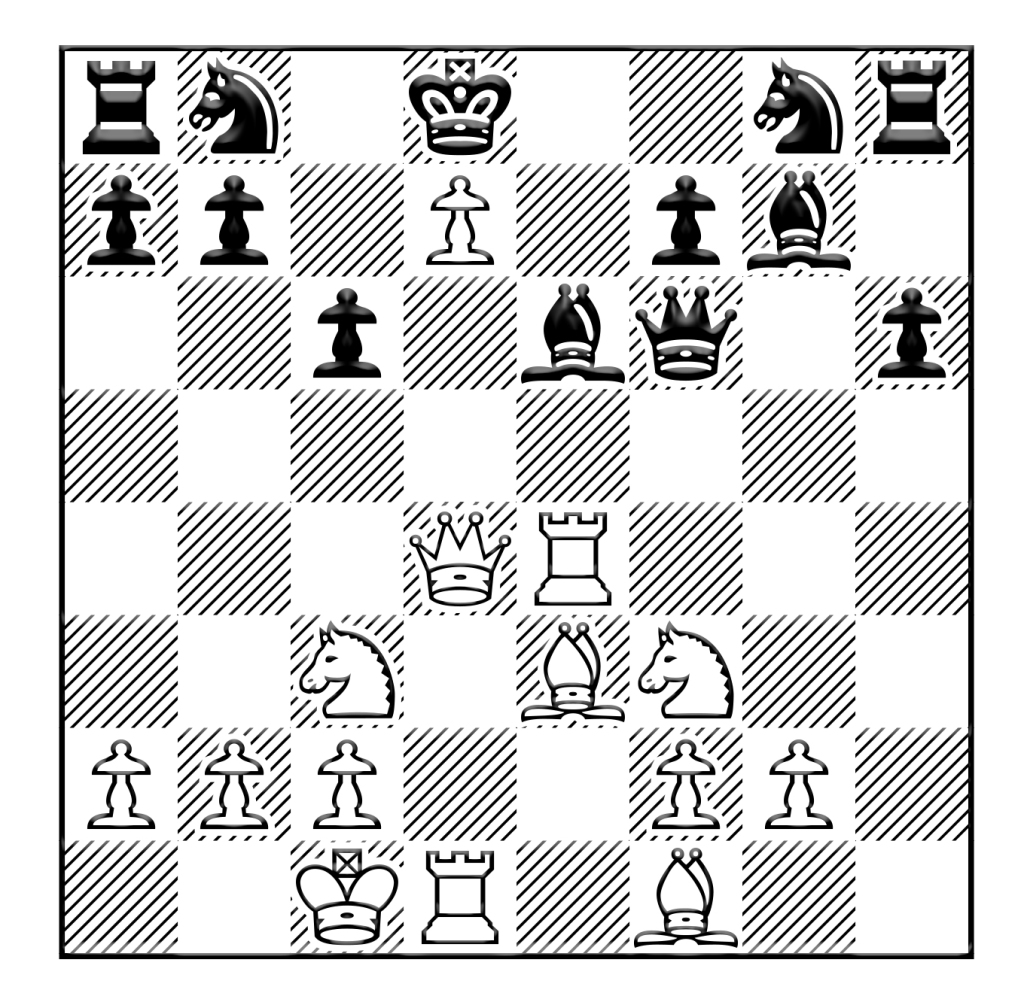What is the Borg? For Star Trek aficionados, they are an evil group of aliens who kidnap indigenous and sentient life forms and enslave them by use of electronic and computer implants.
But for the chess player, it is a dangerous, reply by Black against 1.e4. And when we say dangerous, we mean dangerous for Black, not White.
What makes this opening so bad for Black?
First of all, White can open the game with 1.g4 and Black can’t stop that move. But Black can really only play this move after 1.e4 (Both 1.d4 g5? 2.Bxg5 and 1.Nf3 g5? 2.Nxg5 quickly loses the game for Black).
Secondly, no one have ever claimed that 1.g4 is a good move. And it’s even worse when it is played a move behind for the following reason:
Thirdly, the move 1.g4 severely weakens White and since Black is a move behind, his reply 1…g5 weakens him even more.
But how did Black’s opening 1.e4 g5 get the name, Borg? Well, the move 1.g4 is known as Grob’s Opening. And Borg is Grob spelled backwards.
But this name only took hold after Star Trek, The New Generation introduced the Borg in an episode titled, “Q Who?”, which aired on May 8, 1989.
So maybe there is something to all this.
Back to the original post!
~~~~~~~~~~~~~~~~~~
Borg
1.e4 g5
1) 1.e4 g5
2) 1.e4 g5 2.d4
3) 1.e4 g5 2.d4 h6 3.f4
4) 1.e4 g5 2.d4 h6 3.h4
————————————
Borg-1
1.e4 g5 2.d4
The most common response is 2.d4 and at least threaten the pawn on g5 with his c1-bishop. Black can choose to ignore the threat, not really a good idea at this point in the game.
Escalante-“menapaiolin”
Blitz Game
Yahoo, Jan. 1 2003
1.e4 g5 2.d4 g4? 3.Qxg4 d5 4.Qe2 dxe4 5.Qxe4 Nf6 6.Qd3 Bg4 7.Be2 Bh5?? 8.Bxh5 Nxh5 9.Qb5+ c6 10.Qxh5 -+ Nd7 11.Nc3 e6 12.Bf4 Bb4 13.Nge2 Bxc3+ 14.Nxc3 Qb6 15.O-O-O a5 16.Ne4 a4 17.Nd6+ Kd8

18.Nxf7+ Kc8 19.Nd6+!! (Much better than taking the rook and losing the initiative. Keep the enemy king on the run!) 19… Kd8 20.Qg5+ Nf6 21.Qxf6+ Kd7 22.Qf7+ Kd8 23.Nc4 Qxb2+ 24.Kxb2 b5 25.Bd6 a3+ 26.Kb1 bxc4 27.Qc7+ Ke8 28.Qe7mate 1-0
Alan R. LeCours-Richard Pugh
New York Ch.
Kerhonkson, Aug. 31 2003
1.e4 g5 2.d4 e5?! 3.d5 d6 4.Nc3 g4 5.Be3 Nf6 6.Qd2 Nbd7 7.O-O-O Rg8 8.Bd3 a6 9.Nge2 Nc5 10.Ng3 Bd7 11.Kb1 b5 12.Nce2 a5 13.c3 b4 14.c4 a4 15.Nc1 c6 16.f3 Qa5 17.Rhe1 Nb3 18.axb3 a3 19.bxa3 (19…Qxa3 20.Qa2, and White keep his extra piece.) 1-0
Escalante-“Chsstrrrst” (1637)
Blitz Game
chess.com, Jan. 16 2021
1.e4 g5 2.d4 d5 3.e5 c5 4.Bxg5 Qb6 5.Qc1= [The chess.com computer says this is an error and suggests the sharper 5.c4, and then the question becomes, can Black reasonably take the b2-pawn with his Queen?
5…Qxb2 6.Nd2, White’s best move, and now:
6…Qxd4?! 7.Ngf3 +/- Qg4 8.cxd5!, and the position between +/- and +- for White.
6…cxd4 7.Bxc4, and White has the advantage.
6…Nc6 7.Rb1 Qxa2 8.Ngf3, and there should be an infinity sign here (which means an unclear position, but I can’t upload that symbol here).]
6.cxd4 6.Nf3 Nc6 7.Bd3 Bg4 8.Nbd2 O-O-O 9.O-O f6 10.exf6 exf6 11.Bf4 h5 12.h3 Bd7 13.Nh4 Nh6? (Better is 13…Ne5 as the move not only stops Ng6, but White can’t open the c-file with c4.) 14.Ng6 +/- Bg7 15.Nxh8 Rxh8 16.Nf3 Nf5 17.Re1 Nb4 18.Qd2 Nxd3 19.cxd3! (Finally, opening the c-file and Black is ill equipped to defend his isolated king on that file.) 19…h4

20.Rac1+ Bc6 (20…Kd8 21.Bc7+ Qxc7 22.Rxc7 Kxc7 23.Qa5+ +-) 21.Qe2 Kd8 22.Qe6 Bd7 23.Qxd5 Ne7 24.Qf7 Bf8 25.Bc7+ Qxc7 26.Rxc7! Kxc7 27.Rxe7 Bxe7 28.Qxe7 Re8 29.Qc5+ Bc6 30.Nxd4 Re5 31.Qc3 a6 32.Nxc6 bxc6 33.d4 Rd5 34.Kf1 a5 35.b4 a4 36.a3 f5 37.Ke2 Kd7 38.Kf3 1-0 (T)
Borg-2
1.e4 g5 2.d4 Bg7
If Black chooses to ignore the Bxg5 threat, he might also want to counter-attack. And he occasionally succeeds.
IM Craig W. Pritchett-IM Michael J. Basman
Great Britain Ch.
Southampton, England, 1986
1.e4 g5 2.d4 Bg7 3.Nc3 c5!? (This is an interesting, and possibly even a good, move.) 4.d5 h6 5.h4?! (This is possibly where White starts to go wrong. The position is closed and he should not open it up so soon.) 5…gxh4 6.Nf3 d6 7.Nxh4 Nd7 8.Nf5 Bxc3+ 9.bxc3 Ne5 10.Bb5+ Kf8 11.Be2 Qa5 12.Kf1 Bxf5 13.exf5 Nf6 14.Rxh6 Kg7 15.Rxh8 Rxh8 16.Kg1 Qxc3 17.Rb1 Ne4 18.Bh5 Qd4 19.Be3 Qxd1+ 20.Bxd1 Nc3 21.Ra1 Nxd5 22.Bc1 b5 23.Bb2 f6 24.Rb1 b4 25.Be2 Nf4 26.Bf1 Rh5 27.Bxe5 fxe5 28.g4 Rg5 29.f3 Kf6 30.a3 a5 31.axb4 axb4 32.Bc4 d5 33.Bf1 Rg8 34.Ra1 Rb8 35.Ra6+ Kg5 36.Ra7 c4 37.Rxe7 b3 38.cxb3 cxb3 0-1
But if White remains flexible, he can often take the pawn and still have enough pieces and space to engineer an attack. There is also the issue of Black trying to win the b2-pawn with his queen.
Vladimir Petrienko-Jan Svatos
Trimex Open
Pardubice, Czech Republic, 1992
1.e4 g5 2.d4 Bg7 3.Bxg5 c5 4.Be3 Qb6 5.Nc3 (Again, we have the question about Black taking the b-pawn with his queen. The biggest counter-threat from White is of course, Nd5. So, again, is it worth for Black to take the b-pawn? According to result of this game, the answer is No.)

5…Qxb2?! 6.Nd5 Kd8 7.Rb1 Qxa2 8.Ra1 Qb2 9.Bc4 cxd4 10.Ra2 dxe3 11.Rxb2 exf2+ 12.Kxf2 Bxb2 13.c3 Nc6 14.Qd2 Ba3 15.Qg5 Bc5+ 16.Ke2 Bd4 17.cxd4 Nxd4+ 18.Kf2 Ne6 19.Qh5 f6 20.Nf3 b6 21.Rd1 Bb7 22.Nxb6 1-0
Gennadi Ginsburg-T. Frey
Neckar Open
Deizisau, Germany, Apr. 6 1998
1.e4 g5 2.d4 Bg7 3.Nc3 c6?! 4.Bc4 b5 5.Bb3 a5 6.a3 Ba6 7.Qf3 e6 8.e5 d5 9.exd6 Bxd4 10.Ne4 Nd7 11.Ne2 Bg7 12.Bxg5 Qc8 13.O-O c5 14.c4 Bb7 15.cxb5

15…f5? 16.Bxe6 Bxe4 17.Qb3 c4 18.Bxc4 Ngf6 19.f3 Bd5 20.Qe3+ Kf8 21.Qe7+ Kg8 22.Bxd5+ 1-0
Iulia Mashinskaya (2268)-Nikolai Vlassov (2492)
Blitz Game, Chess Planet
Russian Cup, Sept. 7 2004
1.e4 g5 2.d4 Bg7 3.Bxg5 c5 4.c3 Qb6 5.Bc1 cxd4 6.Nf3 Nc6 7.Bc4 d6 8.O-O Nf6 9.Re1 Bg4 10.h3 Bh5 11.cxd4 Bxf3 12.Qxf3 Nxd4 13.Qd1 O-O 14.Nc3 Rac8 15.Bd3 Ne6 16.Nd5 Qd8 17.Nxf6+ Bxf6 18.Bh6 Bg7 19.Bxg7 Kxg7 20.Re3 Kh8 21.b3 Rc5 22.Bc4 b5 23.Bd5 Nf4 24.Rf3 e5 25.b4 Rc7 26.Bb3 Rg8 27.Rg3 Rxg3 28.fxg3 Ne6 29.Qd5 Nd4 30.Rf1 Nxb3 31.axb3 Kg7 32.Qxb5 Qg5 33.Qd3 Qg6 34.Kh2 h5 35.h4 a6 36.Qxa6 Rc3 37.Rf3 Rc2 38.Qd3 Rc1 39.Rf5 Qe6 40.Rxh5 Qc8 41.Rg5+ Kh7 42.Qf3 1-0
GM Alexandre Dgebuadze-Man Thomanek
Staufer Open
Leinzell, Jan. 2 2011
1.e4 g5 2.d4 Bg7 3.Bxg5 c5 4.Nf3 cxd4 5.Bc4 Nc6 6.O-O d6 7.Nbd2 Bg4 8.Be2 Bf6 9.Bxf6 Nxf6 10.Nxd4 Nxd4 11.Bxg4 Rg8 12.Bh3 Rc8 13.c3 Ne6 14.Qa4+ Kf8 15.Bxe6 fxe6 16.Rad1 Rc5 17.Nf3 b5 18.Qxa7 Qe8 19.e5 Qg6 20.Nh4 Qg5 21.exf6 Qxf6 22.Rd4 Rh5 23.g3 e5 24.Qa8+ Kf7 25.Qd5+ Kf8 26.Rb4 e4 27.Qxe4 1-0
If Black chooses to defend his pawn, his best option is to play 2…h6. White has several moves to counter this defensive move.
Two of the more interesting ways are 3.f4 and 3.h4, with 3.h4 being considered the strongest.
Borg-3
1.e4 g5 2.d4 h6 3.f4
Pablo Michel-Kurt Richter Sr.
Germany Ch.
Bad Oeynhausen, 1938
1.e4 g5 2.d4 h6 3.f4 Bg7 4.c3 gxf4 5.Bxf4 c5 6.dxc5 b6 7.Qg4 Kf8 8.Qg3 Na6 9.cxb6 Qxb6 10.Qf2 Nf6 11.Qxb6 axb6 12.Nf3 Nc5 13.Nbd2 Nfxe4 14.Nxe4 Nxe4 15.Be5 Bxe5 16.Nxe5 Rg8 17.Bd3 Nc5 18.O-O Nxd3 19.Nxd3 Ba6 20.Rf3 Rg5 21.b3 Rc8 22.c4 Bb7 23.Rf2 d5 24.Nf4 Kg7 25.cxd5 Bxd5 26.Re1 e6 27.h4 Rg4 28.Nxd5 exd5 29.Ref1 Rc7 1/2-1/2
Lisa Schut (1918)-Jacob Perrenet
Maastricht Limburg Open
The Netherlands, May 26 2007
1.e4 g5 2.d4 h6 3.f4 Bg7 4.fxg5 hxg5 5.Bxg5 c5 6.Be3 Qb6 7.Nc3 cxd4 8.Nd5 dxe3 9.Nxb6 axb6 10.c3 Nf6 11.Bd3 d5 12.Bb5+ Bd7 13.Bxd7+ Nbxd7 14.Ne2 dxe4 15.Nd4 Ra5 16.Qe2 Rg5 17.O-O-O Ne5 18.h4 Nd3+ 19.Kb1 Rc5 20.Nb3 Rc6 21.Qxe3 Bh6 22.Qe2 Rg8 23.Rhf1 Re6 24.Nd4 Nf4 25.Qb5+ Kf8 26.Nxe6+ Nxe6 27.Qxb6 e3 28.Rfe1 Rxg2 29.Rxe3 Bxe3 30.Qxe3 Rh2 31.Qb6 Rxh4 32.Qxb7 Ne4 33.Qb8+ Kg7 34.Rg1+ Kf6 35.Rf1+ Kg7 36.Rg1+ Kf6 37.a4 Nd2+ 38.Kc2 Nf3 39.Rf1 Neg5 40.Qg3 1-0
Borg-4
1.e4 g5 2.d4 h6 3.h4
Georgios Alexopoulos (2249)-Hristos Giannopoulos
Match
Greece, 1969
1.e4 g5 2.d4 h6 3.h4 gxh4 4.Rxh4 e5 5.Nf3 exd4 6.Qxd4 Qf6 7.e5 Qe7 8.Nc3 c6 9.Be3 d5 10.exd6 Qf6 11.Re4+ Be6 12.O-O-O Bg7 13.d7+ Kd8

14.Qb6+!! axb6 15.Bxb6+ Ke7 16.d8=Qmate 1-0
Philip Giulian (2295)-Michael Basman (2350)
Troon
Scotland, 1986
1.d4 h6 2.e4 g5 3.h4 g4 4.Qxg4 d5 5.Qe2 dxe4 6.Qxe4 Nf6 7.Qd3 Nc6 8.c3 Qd5 9.Nf3 Rg8 10.Nbd2 Bg4 11.Nc4 O-O-O 12.Ne3 Qd6 13.Nxg4 Nxg4 14.Qf5+ Kb8 15.Bf4 e5 16.Nxe5 Nxd4 17.Nxg4 Nc2+ 18.Qxc2 Qxf4 19.Ne3 Bc5 20.g3 Rxg3 21.fxg3 Qxe3+ 0-1
Marcus Osborne (2233)-Michael Basman (2360)
Great Britain Ch.
Torquay, 1998
1.e4 g5 2.d4 h6 3.h4 g4 4.Qxg4 d5 5.Qf4 dxe4 6.Nc3 Bg7 7.Bc4 e6 8.Nge2 Nf6 9.Nb5 Na6 10.b3 Bd7 11.Ba3 Bxb5 12.Bxb5+ c6 13.Bxa6 Qa5+ 14.Kf1 Qxa6 15.Bc5 Nd7 16.Rd1 O-O-O 17.Bd6 f5 18.a4 Nf6 19.c4 Nh5 20.Qh2 Qa5 21.c5 Rd7 22.Be5 Qb4 23.Bxg7 Qxb3 24.Ra1 Rxg7 25.Qe5 Rhg8 26.Rh3 Qd5 27.Rb1 f4 28.Rhb3 Qxe5 29.dxe5 Rd8 30.Nc3 Rd4 31.Rb4 Rxb4 32.Rxb4 e3 33.fxe3 fxe3 34.g4 Rf7+ 35.Ke2 Nf4+ 36.Kxe3 Nd5+ 37.Nxd5 cxd5 38.g5 hxg5 39.hxg5 Rg7 40.Rg4 Kd7 41.g6 Ke7 42.Kf4 Kf8 43.Kg5 Kg8 44.Kf6 Rc7 45.Rh4 a5 46.Kxe6 Rxc5 47.Kf6 Rc1 48.e6 Rf1+ 49.Ke7 Kg7 50.Rg4 d4 51.Rxd4 Kxg6 52.Kd7 1-0
